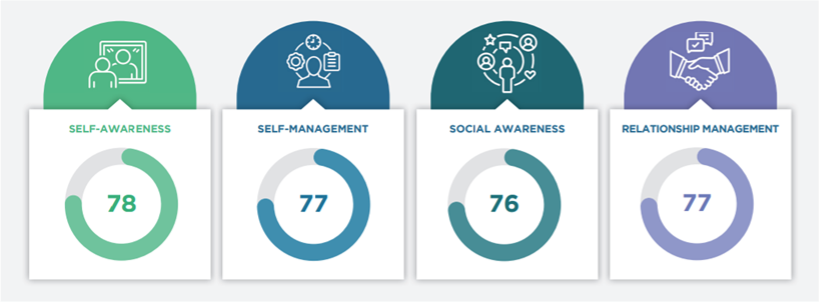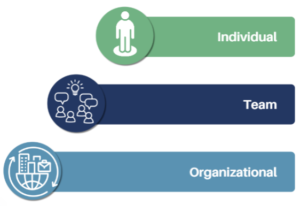Imagine knowing exactly what makes your workplace tick – the hidden patterns that drive collaboration, the subtle cues that build trust, and the skills that separate high-performing teams from the rest. TalentSmartEQ’s first annual State of EQ Report gives insight into hundreds of organization’s priorities and how EQ can influence outcomes. The report showed that 81% of people identified collaboration as a top organizational priority, while 78% of people also identified priorities in customer satisfaction and employee engagement. This relationship centric focus isn’t surprising in an era of rapid technological change and economic uncertainty. We are dependent more than ever on finding stability within our teams that allow for successful communication in the interconnectedness of today’s landscape.
Our analysis of over 37,000 Emotional Intelligence Appraisal® results reveals an intriguing pattern that impactthe success of relationship-centered goals. This analysis shows how organizations can leverage their EQ strengths to achieve their collaboration and engagement priorities at every level – from individual contributors to senior leaders.
The Highest and Lowest Skill Scores
The overall EQ score was 77, indicating that professionals are likely aware of a lot of the behaviors that make their impact effective and there is room for strategic growth. When we examined specific skills, all four skills scored within a narrow range of 76-78. When averages of scores are this narrow, a two-point difference can be meaningful and worth paying attention to.

We discovered that 41% of professionals were scoring above 80 in Self-Awareness but that one in three were struggling with reading non-verbal cues, aligning with the opportunity of Social Awareness. This gap between how well people understand themselves versus how well they read others opens exciting opportunities for development and provides a focused starting point for emotional intelligence skill building.
Transforming Self-Awareness into Social Excellence: A Three-Level Approach
The Self-Awareness strength we discovered in our analysis gives organizations a powerful advantage. In fact, when we looked deeper at Self-Awareness behaviors, confidence in abilities emerged as the highest-rated item. This confidence provides an ideal foundation for developing other critical skills, like empathy, a critical component to Social Awareness. When professionals understand their own emotional patterns and feel confident in their abilities, they’re better equipped to recognize and interpret patterns in others. While strong Self-Awareness doesn’t guarantee Social Awareness success, this foundation of self-understanding and confidence makes people better equipped to develop the Social Awareness skills needed to close the gap between understanding ourselves and understanding others.

Understanding this connection between self and social awareness opens up exciting possibilities for growth. Leaders can transform this self-awareness advantage into stronger social awareness throughout their organizations. To help you put these insights into action, we’ll explore practical examples of how individual contributors, teams, and entire organizations are building on their self-awareness foundation to create stronger, more connected workplaces.
Individual Level
Developing Social Awareness doesn’t require complex techniques. It starts with simple actions that build powerful observation skills. Imagine closing all your tabs during your next video call. Instead of multitasking, you focus entirely on observing – the subtle changes in facial expressions, shifts in tone, variations in speaking pace. This intentional attention to behavioral baselines helps you connect more effectively with colleagues, ultimately accelerating work and improving outcomes.
Self-Awareness gives you an advantage in reading others. Because you understand your own emotional responses, you have a foundation for recognizing these patterns in colleagues. The key is to use this knowledge thoughtfully. You might notice that a colleague’s tone shifts in a familiar way during discussions – the same way yours does when feeling overwhelmed. Test for accuracy and remember that their reaction might not match yours.
| DO | DON’T |
|
|
Team Level
Developing any emotional intelligence skills at the team level helps establish better norms and drive sustainable change. The State of EQ Report revealed that only 13% of organizations use peer learning programs and 40% reported that feedback is ineffective. Without structured opportunities to build the skills to observe, listen, and adjust, teams miss the chance to strengthen relationships and improve performance.
The power of Social Awareness in teams is backed by compelling research. Featured in the State of EQ report, a Carnegie Mellon study of nearly 700 individuals found that teams with higher social sensitivity consistently outperformed others. These teams didn’t just work better together – they created environments where people felt understood, supported, and able to bring their best selves to work.
At your next meeting, challenge your team to focus on how conversations unfold:
- Who speaks the most? Who rarely speaks?
- How does the tone or energy shift at certain moments?
- Are reactions aligned, or do some seem disengaged?
Then, follow up: Ask team members what’s working in collaboration and what’s not. Small adjustments—like clarifying meeting intent, improving feedback quality, or ensuring all voices are heard—can turn awareness into action and reduce the friction that slows teams down.
This action hinges on the team’s ability to give and receive feedback effectively. Removing uncertainty by providing a systematic approach to feedback makes it easier to share and accept.
Organizational Level
An organization that prioritizes Social Awareness and is built on a foundation of strong Self-Awareness, feels different – meetings are purposeful, feedback is candid but constructive, and employees feel seen, heard, and valued. Collaboration flows more easily because teams don’t just work together; they understand each other. The impact? Less friction, faster decision-making, and higher engagement and retention. But for this to be sustained, Social Awareness can’t just be an individual or team priority—it must be woven into the organization’s culture.
Leadership buy-in is pivotal, but lasting change happens when Social Awareness is built into everyday operations. Organizations that excel in this area make EQ an ongoing conversation, not just a one-time initiative.
One way to reinforce Social Awareness at scale is by integrating EQ-driven behaviors into employee recognition programs. For example, companies can spotlight employees who excel in active listening, cross-team collaboration, or delivering thoughtful feedback. This shifts EQ from a soft skill to a measurable, valued behavior that becomes ingrained in the culture.
When Social Awareness is measured, recognized, and rewarded, it moves from an aspiration to an expectation, sustaining a culture where strong relationships fuel performance, innovation, and long-term success.
EQ as a Strategic Advantage
By helping employees bridge the gap between Self and Social Awareness, organizations can transform their relationship-centric priorities into measurable outcomes.
When managers understand both their own emotional patterns and those of their teams, they make better decisions. When teams can read and respond to subtle social cues, they collaborate more effectively. When organizations build cultures of emotional intelligence, they create environments where both people and performance thrive.
Want to understand how your organization’s EQ profile aligns with these findings? Contact us to explore how TalentSmartEQ can help you leverage emotional intelligence to achieve your strategic priorities.